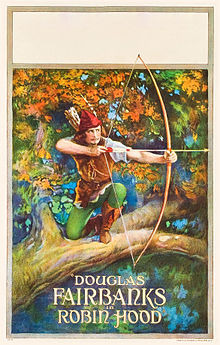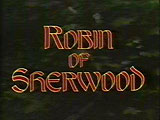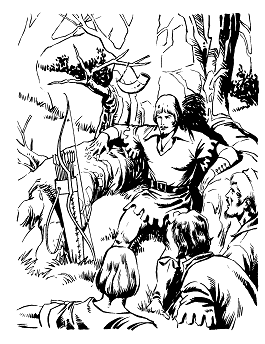
The folkloric hero Robin Hood has appeared many times, in many different variations, in popular modern works.

The folkloric hero Robin Hood has appeared many times, in many different variations, in popular modern works.
Robin Hood has appeared in a number of plays throughout the medieval, early modern and modern periods. The first record of a Robin Hood play being performed is in Exeter in 1426-27. [1] The earliest surviving text of a Robin Hood play is dated c.1475 and entitled Robyn Hod and the Shryff off Notyngham. [2] [3]
The plays which perhaps have been most influential upon the Robin Hood legend as a whole are Anthony Munday's The Downfall of Robert, Earle of Huntington and The Death of Robert, Earle of Huntingdon (1597–98). It is in these plays that Robin is first depicted as a nobleman. Further plays followed during the early modern period such as the anonymous Looke About You (1600) and Robin Hood and his Crew of Soldiers (1661).
On 18 April 1992, BBC Radio 4 first broadcast John Fletcher's 90-minute radio play entitled The Legend of Robin Hood, which was a full cast drama that drew closely on the original Robin Hood ballads. [4] It was directed by Nigel Bryant and featured music composed by Vic Gammon. As well as depicting some of Robin Hood's adventures in Sherwood Forest and Nottingham, it also covers a fruitless quest that Robin makes Little John to the Holy Land to help the crusaders.
On May 18, 2019, Augustine Institute released a full cast 12-part audio drama written and directed by Paul McCusker entitled The Legends of Robin Hood. Starring Gwilym Lee as Robin Hood (a.k.a. Robert of Locksley), Katie Foster-Barnes as Maid Marian (named Marian Fitzwalter in this version), with Robert Portal as Sir Guy of Gisbourne and Nicholas Boulton as Richard the Lionheart.
The first published prose account of Robin Hood's life appears to be the anonymously authored The Noble Birth and Gallant Atchievements of that Remarkable Out-Law, Robin Hood (1678). Material from this work was often plagiarised by criminal biographers in works such as: The Whole Life and Merry Exploits of Bold Robin Hood (1712), Alexander Smith's A Complete History of the Lives and Robberies of the Most Notorious Highwaymen, Footpads, Shoplifts and Cheats (1719), Charles Johnson's Lives and Exploits of the Most Noted Highwaymen (1734). [5] In addition, there were numerous books printed throughout the late seventeenth and eighteenth centuries that went by the name of Robin Hood's Garland. These were cheaply printed collections of later Robin Hood ballads.
The first Robin Hood novel written, although not published, is Robert Southey's 'Harold, or, The Castle of Morford' (1791). [6] [7] This exists in manuscript form in the Bodleian Library. The first published Robin Hood novel was the anonymous Robin Hood: A Tale of the Olden Time (1819), and a few months later Ivanhoe by Walter Scott, 1819. Ivanhoe was Scott's first novel where history and romance is combined. Robin Hood in this book is the saviour of the nation. The Upper classes need the working classes as much as the working classes rely on their 'betters'. [8] Scott's tale is significant because it is the first time that Robin is presented as an Anglo-Saxon freedom fighter, a theme which many later Victorian Robin Hood novels would utilise. The next novel following Scott was Thomas Love Peacock's novella Maid Marian. The novel was originally intended as a satire on continental conservatism and its enthusiasm for all things feudal and medieval, and in particular the unwarranted praise of aristocracy. Thus through his novella Peacock attempted to show how man’s feudal overlords have always been the same: greedy, violent, cynical, and self-interested. [9] Robin also appears as the principal protagonist of two tales printed in an early penny blood entitled Lives of the Highwaymen in 1836. This serialised tale, however, is little more than a reprint of the earlier biography of Robin Hood that appeared in Charles Johnson's work. In Thomas Miller's Royston Gower; or, The Days of King John (1838), Robin is not the principal protagonist but is an outlaw who comes to the aid of the title character after he defects from the Normans and decides to fight against King John for the establishment of a 'charter of rights'. G. P. R. James' Forest Days (1843), while not intended as a political or social commentary, is significant because it abandons the traditional dating of the Robin Hood story in the 1190s and instead places the Robin Hood legend during the Simon de Montfort rebellion (1264-67). By far the longest Robin Hood novel, standing at almost half-a-million words, is Pierce Egan the Younger's Robin Hood and Little John; or, The Merrie Men of Sherwood Forest (serialised 1838-1840). As in Ivanhoe, Robin is a Saxon, although he is not actually outlawed in the novel until nearly the end of the first book. The novel traces Robin's life from birth to death. Egan's text was translated into two French books, Le prince des voleurs (The Prince of Thieves), and Robin Hood le proscrit (Robin Hood the Outlaw), by Alexandre Dumas, between 1863–64. Dumas' works were then retranslated back into English by Alfred Allinson in 1904. A 'companion' novel to Egan's text was published by J. H. Stocqueler in 1849 entitled Maid Marian, the Forest Queen; Being a Companion to "Robin Hood". The first Robin Hood novel written specifically for children appears to be Stephen Percy's Tales of Robin Hood (1840). John B. Marsh's children's book Robin Hood appeared in 1865, as did a penny dreadful entitled Little John and Will Scarlet (1865). The next major novel written was entitled The Merry Adventures of Robin Hood by Howard Pyle in 1883. In T. H. White's novel The Sword in the Stone (1938, later incorporated into The Once and Future King), young Wart (Arthur) and Kay have an adventure with a man they initially call Robin Hood, but are told that his real name is Robin Wood. His merry men refer to him as "Robin 'ood," dropping Ws instead of Hs, in the Nottinghamshire accent of the time. White's theory is supported by the fact that the French call him Robin des Bois, or Robin of the Woods.
The character of Robin Hood appears, either as a playable character or as a major supporting character, in the following games:


Robin Hood is a legendary heroic outlaw originally depicted in English folklore and subsequently featured in literature, theatre, and cinema. According to legend, he was a highly skilled archer and swordsman. In some versions of the legend, he is depicted as being of noble birth, and in modern retellings he is sometimes depicted as having fought in the Crusades before returning to England to find his lands taken by the Sheriff. In the oldest known versions, he is instead a member of the yeoman class. Traditionally depicted dressed in Lincoln green, he is said to have stolen from the rich to give to the poor.

Robin of Sherwood is a British television series, based on the legend of Robin Hood. Created by Richard Carpenter, it was produced by HTV in association with Goldcrest, and ran from 28 April 1984 to 28 June 1986 on the ITV network. In the United States it was shown on the premium cable TV channel Showtime and, later, on PBS. It was also syndicated in the early 1990s under the title Robin Hood. The show starred Michael Praed and Jason Connery as two different incarnations of the title character. Unlike previous adaptations of the Robin Hood legend, Robin of Sherwood combined a gritty, authentic production design with elements of real-life history, 20th-century fiction, and pagan myth. Robin of Sherwood has been described by historian Stephen Knight as "the most innovative and influential version of the myth in recent times". The series is also notable for its musical score by Clannad, which won a BAFTA award. A video game adaptation, Robin of Sherwood: The Touchstones of Rhiannon, was released in 1985.

Little John is a companion of Robin Hood who serves as his chief lieutenant and second-in-command of the Merry Men. He is one of only a handful of consistently named characters who relate to Robin Hood and one of the two oldest Merry Men, alongside Much the Miller's Son. His name is an ironic reference to his giant frame, as he is usually portrayed in legend as a huge warrior – a 7-foot-tall (2.1-metre) master of the quarterstaff. In folklore, he fought Robin Hood on a tree bridge across a river on their first meeting.

Sir Guy of Gisbourne is a character from the Robin Hood legends of English folklore. He first appears in "Robin Hood and Guy of Gisborne", where he is an assassin who attempts to kill Robin Hood but is killed by him. In later depictions, he has become a romantic rival to Robin Hood for Maid Marian's love.
Maid Marian is the heroine of the Robin Hood legend in English folklore, often taken to be his lover. She is not mentioned in the early, medieval versions of the legend, but was the subject of at least two plays by 1600. Her history and circumstances are obscure, but she commanded high respect in Robin’s circle for her courage and independence as well as her beauty and loyalty. For this reason, she is celebrated by feminist commentators as one of the early strong female characters in English literature.

Conquests of the Longbow: The Legend of Robin Hood is a graphic adventure game designed by Christy Marx and published by Sierra On-Line in 1991. It is the second and final part of the Conquests series, which begins with Conquests of Camelot: The Search for the Grail. It features VGA graphics and Sierra's standard icon-driven interface first seen in King's Quest V.
Much, the Miller's Son is one of the Merry Men in the tales of Robin Hood. He appears in some of the oldest ballads, A Gest of Robyn Hode and Robin Hood and the Monk, as one of the company.
Alan-a-Dale is a figure in the Robin Hood legend. According to the stories, he was a wandering minstrel who became a member of Robin's band of outlaws, the "Merry Men".
Will Scarlet is a prominent member of Robin Hood's Merry Men. He is present in the earliest ballads along with Little John and Much the Miller's Son.

The Merry Adventures of Robin Hood of Great Renown in Nottinghamshire is an 1883 novel by the American illustrator and writer Howard Pyle. Pyle compiled the traditional Robin Hood ballads as a series of episodes of a coherent narrative. For his characters' dialog, Pyle adapted the late Middle English of the ballads into a dialect suitable for children.
Richard at the Lee is a major character in the early medieval ballads of Robin Hood, especially the lengthy ballad A Gest of Robyn Hode, and has reappeared in Robin Hood tales throughout the centuries.
"Robin Hood and the Golden Arrow" is Child ballad 152. It features an archery competition for a golden arrow that has long appeared in Robin Hood tales, but it is the oldest recorded one where Robin's disguise prevents his detection.

Robin Hood: The Legend of Sherwood is a 2002 stealth-based real-time tactics video game developed by Spellbound Entertainment. It is similar to games such as Desperados: Wanted Dead or Alive and the Commandos series. In the game, the player controls up to five characters in a setting based on the stories of the protagonist, Robin Hood. The player can also control Robin Hood's Merry Men, including Little John, Friar Tuck, Will Scarlet, Will Stutely, and Maid Marian. Robin and his crew must evade the cruel Sheriff of Nottingham and his henchmen and stop the machinations of the vile usurper to England's throne, Prince John. However, Robin must avoid killing enemies as much as possible, or he will not be able to recruit as many new Merry Men.

The Merry Men are the group of outlaws who follow Robin Hood in English literature and folklore. The group appears in the earliest ballads about Robin Hood and remains popular in modern adaptations. History The Merry Men are Robin Hood's group who work to rob from the rich and give to the poor. They have antagonized the tyrannical rule of Prince John while King Richard is fighting in the Crusades. This also puts them into conflict with Prince John's minions, Guy of Gisbourne and the Sheriff of Nottingham.
The Sheriff of Nottingham is the main antagonist in the legend of Robin Hood. He is generally depicted as an unjust tyrant who mistreats the local people of Nottinghamshire, subjecting them to unaffordable taxes. Robin Hood fights against him, stealing from the rich, and the Sheriff, in order to give to the poor; it is this characteristic for which Robin Hood is best known. The Sheriff is considered the archenemy of Robin Hood, as he is the most recurring enemy of the well-known outlaw.

Friar Tuck is one of the Merry Men, the band of heroic outlaws in the folklore of Robin Hood.

Robin Hood is a fictional character appearing in media published by DC Comics, based on the legendary character of the same name. The character debuted in New Adventure Comics vol. 1 #23, and was created by Sven Elven.

Tom and Jerry: Robin Hood and His Merry Mouse is a 2012 American animated direct-to-video action-adventure musical comedy film starring the seven-time Academy Award-winning cat-and-mouse duo Tom and Jerry as well as the historical and heroic outlaw Robin Hood. Produced by Warner Bros. Animation and Turner Entertainment Co., the film was released on DVD and Blu-ray on September 28, 2012.

Lady of Sherwood is a 1999 historical fiction novel by American author Jennifer Roberson. It is a sequel to her 1992 novel Lady of the Forest, and follows Robin Hood, Lady Marian, and their associates, as they fight injustices in the wake of the death of King Richard. They must fight the machinations of Prince John, who is competing for the throne against his young nephew, Arthur of Brittany.